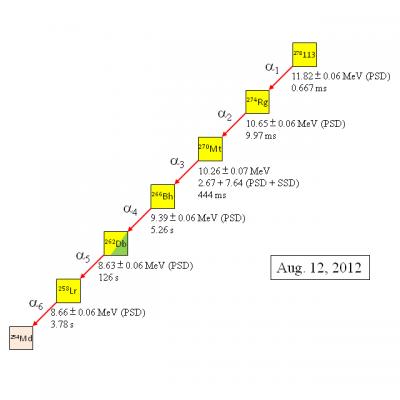Over nine years of research to conclusively identify element 113 has borne fruit.
 "Observed Decay Chain
Credit: RIKEN"
"Observed Decay Chain
Credit: RIKEN"
Researchers at the RIKEN Nishina Center for Accelerator-based Science (RNC) conducted experiments at the RIKEN Radioisotope Beam Factory (RIBF) and produced a six-step alpha decay chain following the production of a very heavy ion. The alpha decays have been identified as isotope products of the 113th element. This allows Japan to stake the claim for naming the elusive element.
Superheavy elements do not occur in nature. Particle accelerators or nuclear reactors are used to create these elements through neutron absorption or nuclear fusion. The Americans have discovered the elements 93 to 103, the Russians and Americans have together discovered the elements 104 to 106 and 114 and 116, and the Germans have discovered the elements 107 to 112. The discovery of the 113th element will make Japan as a member of this list and the first Asian country to have the honor of naming an atomic element.
Kosuke Morita, an associate chief scientist at the RNC, performed experiments at the RIKEN Linear Accelerator Facility along with his team. In order to identify the reaction products, they used a customized gas-filled recoil ion separator (GARIS) which was coupled to a position-sensitive semiconductor detector. In the experiment, zinc ions that were travelling at 10% of the speed of light were made to collide with a thin bismuth layer. A very heavy ion was produced and following that a consecutive six-step alpha decay chain occurred. These decays were found to be isotope products of the 113th element.
In these experiments, dubnium decayed into lawrencium-258 (element 103) initially and then into mendelevium-254 (element 101). This provided clear proof that the origin of the chain was atomic element 113.
The study has been published in the Journal of Physical Society of Japan.